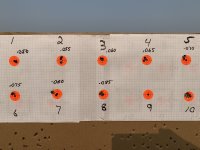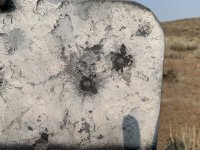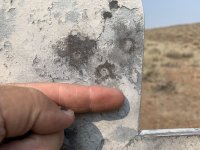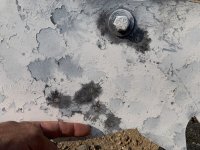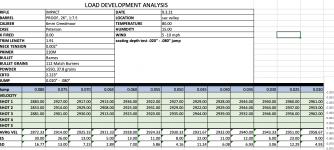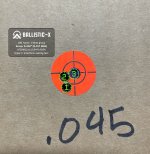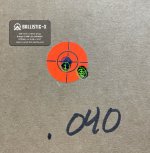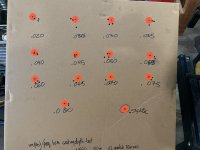Is there any reason not to just load for a particular velocity and then tune via seating depth adjustment?
Join the Hide community
Get access to live stream, lessons, the post exchange, and chat with other snipers.
Register
Download Gravity Ballistics
Get help to accurately calculate and scope your sniper rifle using real shooting data.

Install the app
How to install the app on iOS
Follow along with the video below to see how to install our site as a web app on your home screen.
Note: This feature may not be available in some browsers.
You are using an out of date browser. It may not display this or other websites correctly.
You should upgrade or use an alternative browser.
You should upgrade or use an alternative browser.
Find a node or pick a velocity and then tune seating depth
- Thread starter Gregor.Samsa
- Start date
Is there any reason not to just load for a particular velocity and then tune via seating depth adjustment?
Nope.
Make sure your powder charge weighs the same every time, and get as close as you can to crafting the same exact high-quality finished round every time, over and over, same as last time, and the time before that, just like next time, and the time after that, etc...
...and magically, you will have found a "node". That's all it ever is.
Last edited:
Pick a speed. Load. Use tuner or play with depth. I do the former.
And then wear out your barrel, and start again.....



I cheated on my latest new barrel.
Seated a bullet a bit long and dropped it into the chamber. (Barrel not installed)
Kept doing that until I could rotate the cartridge and added another .005.
Primed 20 cases and dropped 30.0gr Varget and went shooting.
Got my velocity and a quick dope to 1200yds.
The only thing I've changed since that day is going from the 105 Berger to the 105 Match Burner.
Not much of a change at all.
BTW, it's a 6-BR so it's kind of an easy button.
Seated a bullet a bit long and dropped it into the chamber. (Barrel not installed)
Kept doing that until I could rotate the cartridge and added another .005.
Primed 20 cases and dropped 30.0gr Varget and went shooting.
Got my velocity and a quick dope to 1200yds.
The only thing I've changed since that day is going from the 105 Berger to the 105 Match Burner.
Not much of a change at all.
BTW, it's a 6-BR so it's kind of an easy button.
I gave up on finding a node due to inconsistent results. I just work up to max velocity, then pick a speed range I like, load, and tune seating depth. Except for 6BR. Theres a standard load that just works for that cartridge.
Thanks for the replies gents. What's a good seating depth interval to test? I did the velocity test seated .020 out.
thanks. take .005" steps out or at closer intervals?I start 10k off and then work out to 40k. Usually I find something in there to go with. This is with Berger hybrids and Sierra Match kings
Honest question as either clearly works.
For an AR in 556 with less room to mess with seating depth?
Found a load that is consistently .5-.6 moa. at 100 yds, near max per Sierra loading book (granted, for AR in .223). Load is 23.7 Varget under 77 SMK.
SLOW, though I put 25 rounds on steel at 600 and measured about 8", even holding a 1 mil wind hold.
Not sure I should chase more speed, but well below what I though I would get from an 18' Proof with that charge.
For an AR in 556 with less room to mess with seating depth?
Found a load that is consistently .5-.6 moa. at 100 yds, near max per Sierra loading book (granted, for AR in .223). Load is 23.7 Varget under 77 SMK.
SLOW, though I put 25 rounds on steel at 600 and measured about 8", even holding a 1 mil wind hold.
Not sure I should chase more speed, but well below what I though I would get from an 18' Proof with that charge.
Thanks for the replies gents. What's a good seating depth interval to test? I did the velocity test seated .020 out.
Well, .020" off the lands has been the ubiquitous defacto standard since the beginning of time... that said, times change, and depending on what you're shooting and what style of shooting you do, you can get more adventurous if you want and go with a bigger jump...
For me, shooting 6mm creedmoor and for PRS-style shooting, I jump like a MF'er since I spend most of my time shooting 600+ yards and don't want what groups look like at 100 influencing my decisions too much (especially since most of the time a bad group has more to do with the a-hole pulling the trigger than the load). But, I could give a shit about examining groups at 100, I want "baseball or less" at 600... for the life of the barrel if I can get it.
Currently I'm jumping ~.100" with 112gr Match Burners and have done the same with thousands of DTAC's... my rifles shoot pretty much the same from 200ish rounds on 'em until they're dead and I mostly don't have to adjust a damn thing until it's dead. I also get a lot more barrel life than you used to typically hear of with 6creed: running "slow" Dasher-ish speeds with a healthy jump I'm getting 2000+rds easy (I took my last barrel off at 2300rds to spin a new barrel on since I was selling that old rifle to a buddy, and I was actually kind of bummed taking off the old barrel because it was still .5moa at 100 and .5moa 1000... I was hoping to find out how long it'd go...).
I don't even test any closer than .060" anymore.
Have a look at this:

 www.snipershide.com
www.snipershide.com

Are Velocity Flat Spots a Myth?
Controversial topic here. Are velocity “flat spots” based on powder charge a myth?
Thanks. I'm planning on running 112 MBs as well in a 6 creedmoor. What speeds are you hitting?Well, .020" off the lands has been the ubiquitous defacto standard since the beginning of time... that said, times change, and depending on what you're shooting and what style of shooting you do, you can get more adventurous if you want and go with a bigger jump...
For me, shooting 6mm creedmoor and for PRS-style shooting, I jump like a MF'er since I spend most of my time shooting 600+ yards and don't want what groups look like at 100 influencing my decisions too much (especially since most of the time a bad group has more to do with the a-hole pulling the trigger than the load). But, I could give a shit about examining groups at 100, I want "baseball or less" at 600... for the life of the barrel if I can get it.
Currently I'm jumping ~.100" with 112gr Match Burners and have done the same with thousands of DTAC's... my rifles shoot pretty much the same from 200ish rounds on 'em until they're dead and I mostly don't have to adjust a damn thing until it's dead. I also get a lot more barrel life than you used to typically hear of with 6creed: running "slow" Dasher-ish speeds with a healthy jump I'm getting 2000+rds easy (I took my last barrel off at 2300rds to spin a new barrel on since I was selling that old rifle to a buddy, and I was actually kind of bummed taking off the old barrel because it was still .5moa at 100 and .5moa 1000... I was hoping to find out how long it'd go...).
I don't even test any closer than .060" anymore.
I do .003” incrementsthanks. take .005" steps out or at closer intervals?
Thanks. I'm planning on running 112 MBs as well in a 6 creedmoor. What speeds are you hitting?
I'm only going ~2850fps... so like a pretty average Dasher. There's no need to run up to 3100-3200fps just because you can.
It's soft, shoots great, barrel lasts, components are everywhere and one can run both LRP's and SRP's, and kind of makes one wonder why anyone would want to dick around with the hassle of tracking down stuff for something more exotic or hip like 6GT or dealing with mag kit headaches with 6BR/BRA/BRX/Dasher/etc when 6CM "ran slow" works awesome.
Keep in mind that I'm getting away with this because I'm using Sta-Ball exclusively, and that's a pretty important part to my recipe. Case-fill with ball powders doesn't really matter (my rounds sound like salt & pepper shakers when you shake them next to your ear there's so much empty capacity in them), not sure, but I doubt one could run a 6CM like this with extruded stick powder like with the usual suspects like H4350/H4831SC/RL16/etc.
To be specific, I should probably mention I'm basing my jump number off of my jam length number (the CBTO of a dummy round's jam length using Erik Cortina's method)... If one were to use the Deep Creek method (which I think I'm starting to like better since different guys can arrive at the same numbers), it sounds a lot less crazy and my jump is "only" .055"... I've been meaning to experiment with jumping .100" from the lands using the Deep Creek method, just haven't gotten around to it since it's sort of dumb to keep testing shit when your load is already shooting well enough where you're making called headshots on IPSC's at 1000yrds...
FWIW, when testing for jump I use at least .010" increments (i.e. .040", .050", .60", etc.). Other then hearing Scott Saterlee mention it, you don't hear a lot of guys talk about "durability"... and these 6mm's change over time as the round count adds up and the throat cooks. I don't care at all if .010" off the lands shoots bugholes if it's going to turn to garbage and I'm going to have to readjust my load every ~200rds or so... I test for a jump range of at least .040" wide that shoots good (say .060"-.100") that way I can concentrate on my shooting skills instead of my reloading skills. Finding a jump range that's durable and lasts means there aren't many surprises... you won't show up at the range one day and find out the hard way that your gun/load has gone to shit suddenly (which happens from time to time when seating right up on the lands).
Last edited:
Great information, thank you. It’s interesting you bring up case fill. I just tested h4350 vs n550. I get more complete case fill with h4350 but require less n550 to achieve similar velocities. I have equal amounts of each- enough to last approx 1000 rounds. H4350 always seems to be unobtainable and n550 isn’t too common either. When testing velocities the other day, I wasn’t shooting for groups but the n550 seemed to group very tight even though the loads were different. The n550 charges were very linear without any distinct flat spots/ nodes. I am considering the n550 but would like to hear others opinions. Thanks
Last edited:
Yeah, I sort of think case-fill is more of "a thing" than people make it out to be (which sounds funny when talking about a subject where guys argue over turning necks and uniforming flash holes, etc)...
FWIW/IMHO, no science to back it up or anything, but I don't believe in coincidence and I have noticed there seems to be a common thread with the cartridges that have the reputation of being "easy to load for/easy to tune/everything shoots" like 6BR/Dasher in that they are all pretty easy to achieve good case-fill with... and I have a hunch that has something to do with it.
FWIW/IMHO, no science to back it up or anything, but I don't believe in coincidence and I have noticed there seems to be a common thread with the cartridges that have the reputation of being "easy to load for/easy to tune/everything shoots" like 6BR/Dasher in that they are all pretty easy to achieve good case-fill with... and I have a hunch that has something to do with it.
Use this, then use the same load on the next barrel and so on.
Newberry’s system is one I have used for going on ten years and it works well for producing accurate, repeatable ammunition. That said I believe you can pick a charge and adjust seating depth and get similar results.
Use this, then use the same load on the next barrel and so on.
The problem with just picking a velocity and charge is you bypass the “work up” portion of checking for pressure. You also have to fully understand the data that you use. If you have a 16” barrel and think that you can match data from a 24” barrel you are going to be disappointed. Try to achieve their velocity and you’ll end up over pressure.
Also, not all published data appears to be test data. When I inquired to one major bullet manufacturer for a powder recommendation I was sent two pages from their reloading manual and advised the data was based on Quickload.
pick a velocity and run a seating test or tune the load with a tuner...its that simple.
ive ran a tuner the last 2 barrels...current barrel no tuner...after running the tuner for 2 barrels and then looking back ive found it takes more rounds to tune a load with the tuner than it did to just run a seating test...not a huge differance but still a difference...which i do right where i shoot with a lee hand press.
i run 100-120 rounds through a new barrel to get it up to speed then shoot 1 round each increasing the charge weight until i see the velocity im looking for and continue past until i see signs of pressure...the velocities im looking for are well below pressure but i do like to know where it is.
i then will load up X number of rounds...normally 60 rounds...may as well get dopes after my seating test....i was just setting seating at .070 off the lands with the tuner and tune...this barrel without the tuner i started at .050 off and seated back .005 at a time...im a firm believer in bigger jumps stay in tune longer than smaller jumps.
i went with .050 off the lands in this barrel because looking at this seating test it should shoot pretty good through most of its life by just adding powder when it starts to loose velocity.
ive ran a tuner the last 2 barrels...current barrel no tuner...after running the tuner for 2 barrels and then looking back ive found it takes more rounds to tune a load with the tuner than it did to just run a seating test...not a huge differance but still a difference...which i do right where i shoot with a lee hand press.
i run 100-120 rounds through a new barrel to get it up to speed then shoot 1 round each increasing the charge weight until i see the velocity im looking for and continue past until i see signs of pressure...the velocities im looking for are well below pressure but i do like to know where it is.
i then will load up X number of rounds...normally 60 rounds...may as well get dopes after my seating test....i was just setting seating at .070 off the lands with the tuner and tune...this barrel without the tuner i started at .050 off and seated back .005 at a time...im a firm believer in bigger jumps stay in tune longer than smaller jumps.
i went with .050 off the lands in this barrel because looking at this seating test it should shoot pretty good through most of its life by just adding powder when it starts to loose velocity.
Attachments
..im a firm believer in bigger jumps stay in tune longer than smaller jumps.
i went with .050 off the lands in this barrel because looking at this seating test it should shoot pretty good through most of its life by just adding powder when it starts to loose velocity.
^^^ yep, this probably doesn't get pointed out enough.
If you find a jump range (rather than just one depth) where the barrel shoots good, then you can just stick to the same load for a long time, sometimes the entire life of the barrel, without having to change anything. No surprises.
So, using @LR1845's target as an example, since it looks like it shoots good the whole way between .050"-.085", parking it at .050" and forgetting about it for a long time should be fine. As the throat erodes, and the jump gets longer, no big deal, we can see by the target that it stays looking pretty good out to .085" off, so no need to monitor it much, just go shoot.
The thing I'm still messing around with is, in order to get the most consistent performance and longest barrel life: is it better to park it closer to the rifling (starting at the smallest number/start of your jump-range) and "back into" your jump range... or, just park it at the back edge of where you've tested and know it shoots and just leave it there (since the further away from lands/rifling typically the slower the throat erodes)..?
After posting in the thread yesterday, explaining that I was really only .055" off the lands when measured more traditionally (.100" off jam), it occurred to me that I had already sort of tested all the way back to more than .150" off the lands when fire-forming my first 300rds through the barrel, and it was shooting great... So, due to curiosity, and wanting the most stupidly boring, longest lasting barrel I can get, I had 300rds already loaded up to .55" off the lands that I decided to seat deeper to .100" off...
So, if things go like I think they might, I should have a very boring 300rds where my dope doesn't change and the rifle does the same thing. That's the plan anyway...
Thanks for the advice fellas. I just loaded a seating depth test:
6 CM Peterson cases (unfired), 112 Match Burners, 37.8 gr. N550, 210M primers
loaded 3 rounds each in .005” increments from .020”-.080” jump.
My target velocity is 2975- 3025 FPS.
my biggest trepidation on this test is the unfired brass on a barrel with only 60 rounds on it. I’m worried about chasing my tail as case volume expands etc. I’m hoping all variables will achieve an equilibrium of sorts with the barrel speeding up whilst the case volume increases. My experience is limited but I’m sure I’ll learn something regardless
I’ll share results as soon as I am able to carve out some range time.
6 CM Peterson cases (unfired), 112 Match Burners, 37.8 gr. N550, 210M primers
loaded 3 rounds each in .005” increments from .020”-.080” jump.
My target velocity is 2975- 3025 FPS.
my biggest trepidation on this test is the unfired brass on a barrel with only 60 rounds on it. I’m worried about chasing my tail as case volume expands etc. I’m hoping all variables will achieve an equilibrium of sorts with the barrel speeding up whilst the case volume increases. My experience is limited but I’m sure I’ll learn something regardless
I’ll share results as soon as I am able to carve out some range time.
Last edited:
I’ve found that the powder may change with the brass forming but seating depth is usually consistent.
I’ve also found that long jumps may not change as much across a barrels life (but actually across hundreds of different barrels as that’s what the long jump is about: good over a number of different barrels, not optimized for one) but I’ve also found that they aren’t usually the peak accuracy for a barrel. I’ve also found that closer on the lands doesn’t mean that it won’t still to shoot well as the barrel wears. Don’t chase the land measurement, chase where testing shows it’s most accurate.
I’ve also found that long jumps may not change as much across a barrels life (but actually across hundreds of different barrels as that’s what the long jump is about: good over a number of different barrels, not optimized for one) but I’ve also found that they aren’t usually the peak accuracy for a barrel. I’ve also found that closer on the lands doesn’t mean that it won’t still to shoot well as the barrel wears. Don’t chase the land measurement, chase where testing shows it’s most accurate.
Last edited:
interesting observation....im not saying your wrong but i will take credit for the POI shift more than the load or the gun...this is shot prone off a cyke pod and a rear bag...#10 is cold clean barrel then shot #1-#2-#3 and let cool then shot the others...there is most definitely a shift starting .065 but a 10th right and im golden again.Interesting. Your .050” is right on the edge of a huge POI shift. .060” is closer to the two on either side.
im at 500 rounds with this barrel now and ive learned that after cleaning it take 20ish rounds to foul...ive not went into testing if that was part of the shift from .050 to .060 or not but this is .050 off and .060 off the same day to see which shot better at 600yds....050 off is where my finger is and .060 off in the first pic...not much difference at 600yds….last group with my finger in it is at 850yds at .050 off....again im not saying your wrong im just saying its more likely me than the load.
Attachments
Last edited:
I think there's merits to both jumping, and also seating close-in, just depends on what one is after, what kind of shooting they do, and also how they shoot.
If I wanted the smallest 100 yard group I could squeeze out of my rifle I wouldn't be jumping .100", and forget .020" off, I'd be jamming the suckers into the lands and that's where I'd start any seating depth test. But then I also probably wouldn't be firing 10 or 12 shot strings in 90 seconds or less over and over again, and would maybe let my barrel cool down more than just sometimes.
I feel like if one is after less than 1/2"/.5moa at 100 yards, then a large jump is probably not going to be their bag, but if one is after getting .5moa at distances past 100 yards and spends more time shooting 500-1000 than 100, in the words of the great David Lee Roth: "might as well jump".
It's almost always us, period. Definitively saying there's a POI shift happening based on only 9-12rds in the target above is a little much.
If we're all real about it, the groups we shoot only tell us the difference between what looks like it's working, and what's not. Since the shooter is always the biggest variable, at best we can only use what we see to help us make a better educated guess.
If one has a way of taking the shooter out of the equation, like putting their rifle in a mechanical locked-in rest and also have some form of remote trigger actuation, then making calls based on groups becomes a different deal entirely...
If I wanted the smallest 100 yard group I could squeeze out of my rifle I wouldn't be jumping .100", and forget .020" off, I'd be jamming the suckers into the lands and that's where I'd start any seating depth test. But then I also probably wouldn't be firing 10 or 12 shot strings in 90 seconds or less over and over again, and would maybe let my barrel cool down more than just sometimes.
I feel like if one is after less than 1/2"/.5moa at 100 yards, then a large jump is probably not going to be their bag, but if one is after getting .5moa at distances past 100 yards and spends more time shooting 500-1000 than 100, in the words of the great David Lee Roth: "might as well jump".
....again im not saying your wrong im just saying its more likely me than the load.
It's almost always us, period. Definitively saying there's a POI shift happening based on only 9-12rds in the target above is a little much.
If we're all real about it, the groups we shoot only tell us the difference between what looks like it's working, and what's not. Since the shooter is always the biggest variable, at best we can only use what we see to help us make a better educated guess.
If one has a way of taking the shooter out of the equation, like putting their rifle in a mechanical locked-in rest and also have some form of remote trigger actuation, then making calls based on groups becomes a different deal entirely...
ive shot a lotta barrels and in my experience the longer jumps stay more consistent...UNLESS of course you find a load that will shoot consistently with a short jump to a longer jump i personally have found myself chasing the lands when closer and just adding powder when farther off....040 is about as close as i run now.^^^ yep, this probably doesn't get pointed out enough.
If you find a jump range (rather than just one depth) where the barrel shoots good, then you can just stick to the same load for a long time, sometimes the entire life of the barrel, without having to change anything. No surprises.
So, using @LR1845's target as an example, since it looks like it shoots good the whole way between .050"-.085", parking it at .050" and forgetting about it for a long time should be fine. As the throat erodes, and the jump gets longer, no big deal, we can see by the target that it stays looking pretty good out to .085" off, so no need to monitor it much, just go shoot.
The thing I'm still messing around with is, in order to get the most consistent performance and longest barrel life: is it better to park it closer to the rifling (starting at the smallest number/start of your jump-range) and "back into" your jump range... or, just park it at the back edge of where you've tested and know it shoots and just leave it there (since the further away from lands/rifling typically the slower the throat erodes)..?
After posting in the thread yesterday, explaining that I was really only .055" off the lands when measured more traditionally (.100" off jam), it occurred to me that I had already sort of tested all the way back to more than .150" off the lands when fire-forming my first 300rds through the barrel, and it was shooting great... So, due to curiosity, and wanting the most stupidly boring, longest lasting barrel I can get, I had 300rds already loaded up to .55" off the lands that I decided to seat deeper to .100" off...
So, if things go like I think they might, I should have a very boring 300rds where my dope doesn't change and the rifle does the same thing. That's the plan anyway...
agreed...if i was a bench or F-class shooter id definitely have a different approach to seating but im not a group shooter...yet...another 20lbs and 5 or 6yrs and i probably will be LOL!!I think there's merits to both jumping, and also seating close-in, just depends on what one is after, what kind of shooting they do, and also how they shoot.
If I wanted the smallest 100 yard group I could squeeze out of my rifle I wouldn't be jumping .100", and forget .020" off, I'd be jamming the suckers into the lands and that's where I'd start any seating depth test. But then I also probably wouldn't be firing 10 or 12 shot strings in 90 seconds or less over and over again, and would maybe let my barrel cool down more than just sometimes.
I feel like if one is after less than 1/2"/.5moa at 100 yards, then a large jump is probably not going to be their bag, but if one is after getting .5moa at distances past 100 yards and spends more time shooting 500-1000 than 100, in the words of the great David Lee Roth: "might as well jump".
It's almost always us, period. Definitively saying there's a POI shift happening based on only 9-12rds in the target above is a little much.
If we're all real about it, the groups we shoot only tell us the difference between what looks like it's working, and what's not. Since the shooter is always the biggest variable, at best we can only use what we see to help us make a better educated guess.
If one has a way of taking the shooter out of the equation, like putting their rifle in a mechanical locked-in rest and also have some form of remote trigger actuation, then making calls based on groups becomes a different deal entirely...
Alright fellas, I just returned from the range. I'm not the greatest shot combined with some mirage and switchy winds, I don't feel I shot that well today, but here are the results.
6 creedmoor
new Peterson brass
37.8 g N550
112 Match burners
210M primers
26" Proof barrel with 60 rounds on it at the beginning of the test
I am interpreting .040" & .045" jumps being the besrt as they were significantly tighter and the impacts were at POI. ).040" is the tightest group, but .045" seems to be consistent. would you load long and go with .040 to account for throat erosion? My SDs were pretty good (I know, 3 shot groups) across all seating depths. I'm hitting 2930, a little slower than my target but I anticipate the barrel speeding up.
How do you guys read these results?
Thanks for the knowledge and advice.
6 creedmoor
new Peterson brass
37.8 g N550
112 Match burners
210M primers
26" Proof barrel with 60 rounds on it at the beginning of the test
I am interpreting .040" & .045" jumps being the besrt as they were significantly tighter and the impacts were at POI. ).040" is the tightest group, but .045" seems to be consistent. would you load long and go with .040 to account for throat erosion? My SDs were pretty good (I know, 3 shot groups) across all seating depths. I'm hitting 2930, a little slower than my target but I anticipate the barrel speeding up.
How do you guys read these results?
Thanks for the knowledge and advice.
Attachments
You need to look for something like this.
200 yards. .005” increments. 3 groups that are almost identical in size, shape, and POI.

200 yards. .005” increments. 3 groups that are almost identical in size, shape, and POI.
my experience with Vihtavouri so far is that they are a cut above. YMMV.Great information, thank you. It’s interesting you bring up case fill. I just tested h4350 vs n550. I get more complete case fill with h4350 but require less n550 to achieve similar velocities. I have equal amounts of each- enough to last approx 1000 rounds. H4350 always seems to be unobtainable and n550 isn’t too common either. When testing velocities the other day, I wasn’t shooting for groups but the n550 seemed to group very tight even though the loads were different. The n550 charges were very linear without any distinct flat spots/ nodes. I am considering the n550 but would like to hear others opinions. Thanks
Alright fellas, I just returned from the range. I'm not the greatest shot combined with some mirage and switchy winds, I don't feel I shot that well today, but here are the results.
6 creedmoor
new Peterson brass
37.8 g N550
112 Match burners
210M primers
26" Proof barrel with 60 rounds on it at the beginning of the test
I am interpreting .040" & .045" jumps being the besrt as they were significantly tighter and the impacts were at POI. ).040" is the tightest group, but .045" seems to be consistent. would you load long and go with .040 to account for throat erosion? My SDs were pretty good (I know, 3 shot groups) across all seating depths. I'm hitting 2930, a little slower than my target but I anticipate the barrel speeding up.
How do you guys read these results?
Thanks for the knowledge and advice.
do not take this wrong but i have to ask....how long have you been shooting?
first looking at the target you posted i see either a lot of shooter error or your gun does not like that combo you are running.
second IMHO unless your shooting the same combo from the same brand/reamer/smith ECT barrel you had prior to this barrel then starting load development before having a 100ish rounds through it is almost a waste of time because when it speeds up everything is going to change.
N550 is a double base powder which personally i would only use if the choices were use a double base powder or dont shoot...ive shot a lot of double base powders over the years and do not like them because of the temp issues and you being in Sac you see the big temp swings from morning to afternoon...we have the same swings here in nevada.
you have equal amounts of H4350 and N550 correct? put the N550 away for now and run the 4530....the rifle gods themselves developed H4350 and RL-16 for the 308 based 6mm and 6.5mm cartridges your going to piss them off running that N550 LOL!!
this is what i would do now that you are closer or at 100 rounds...clean the barrel and load a few foulers to start your testing off....4350..210M..112MB .050 off 1 round each and pick a velocity from 2850ish to 2930ish then run another seating test from .040 to .070 at .010 increments so 40-50-60-70 off.
now to make this even simpler and faster buy a lee hand press and take it your seating die and calipers to the range and do the seating test right there....find your velocity fisrt as i mention above then load up 50-60-100 or how ever many rounds you want at what ever seating depth you decide to start with then shoot 3 round groups and seat each set back .010 at a time then when you find a good load shoot it at 3-4-500yds and adjust as you see fit.
I disagree. Choosing a velocity and adjusting length can get OK results, and you can happen to end up in a node where POI is consistent. You can also end up in the scatter node. You can also end up with a load you need to rezero in different weather. I think some people are confusing, you can get good enough loads to bang 2 MOA steel, with getting really good results.Newberry’s system is one I have used for going on ten years and it works well for producing accurate, repeatable ammunition. That said I believe you can pick a charge and adjust seating depth and get similar results.
The problem with just picking a velocity and charge is you bypass the “work up” portion of checking for pressure. You also have to fully understand the data that you use. If you have a 16” barrel and think that you can match data from a 24” barrel you are going to be disappointed. Try to achieve their velocity and you’ll end up over pressure.
Also, not all published data appears to be test data. When I inquired to one major bullet manufacturer for a powder recommendation I was sent two pages from their reloading manual and advised the data was based on Quickload.
Thanks for this advice. I’ve been shooting a while, but have really begun learning / focusing on Fundamentals the past couple years. Definitely not a great shot. The mirage was a little disruptive to my sight picture but that comes off as an excuse. This is a new rifle and caliber so I have no previous combos to work from. I wanted to try to preserve the h4350 as I don’t see any more being available anytime soon and I also use it in my 6.5 loads. I was hoping this test would allow me to efficiently select a load without overconsumption of components, but I may have gotten in over my head with this.do not take this wrong but i have to ask....how long have you been shooting?
first looking at the target you posted i see either a lot of shooter error or your gun does not like that combo you are running.
second IMHO unless your shooting the same combo from the same brand/reamer/smith ECT barrel you had prior to this barrel then starting load development before having a 100ish rounds through it is almost a waste of time because when it speeds up everything is going to change.
N550 is a double base powder which personally i would only use if the choices were use a double base powder or dont shoot...ive shot a lot of double base powders over the years and do not like them because of the temp issues and you being in Sac you see the big temp swings from morning to afternoon...we have the same swings here in nevada.
you have equal amounts of H4350 and N550 correct? put the N550 away for now and run the 4530....the rifle gods themselves developed H4350 and RL-16 for the 308 based 6mm and 6.5mm cartridges your going to piss them off running that N550 LOL!!
this is what i would do now that you are closer or at 100 rounds...clean the barrel and load a few foulers to start your testing off....4350..210M..112MB .050 off 1 round each and pick a velocity from 2850ish to 2930ish then run another seating test from .040 to .070 at .010 increments so 40-50-60-70 off.
now to make this even simpler and faster buy a lee hand press and take it your seating die and calipers to the range and do the seating test right there....find your velocity fisrt as i mention above then load up 50-60-100 or how ever many rounds you want at what ever seating depth you decide to start with then shoot 3 round groups and seat each set back .010 at a time then when you find a good load shoot it at 3-4-500yds and adjust as you see fit.
I like the Lee hand press idea. If I start over, should I use my now once fired brass for testing or new unfurled brass (same manufacturer and lot)?
I appreciate the advice!
If you shoot decently with you other gun, there is something up with your gun. There are some shots that are way out, POI is all over the place.
use the fired brass i personally do not do load development with new brass...the lee hand press is about $50 bucks and worth every Penney once you start factoring in your time and expenses traveling back and forth to the range...once you start shooting the 6mm chances are your going make the change anyway...plus if your on top of things you can find H4350...it pops up now and then just gotta keep an eye out and check often.Thanks for this advice. I’ve been shooting a while, but have really begun learning / focusing on Fundamentals the past couple years. Definitely not a great shot. The mirage was a little disruptive to my sight picture but that comes off as an excuse. This is a new rifle and caliber so I have no previous combos to work from. I wanted to try to preserve the h4350 as I don’t see any more being available anytime soon and I also use it in my 6.5 loads. I was hoping this test would allow me to efficiently select a load without overconsumption of components, but I may have gotten in over my head with this.
I like the Lee hand press idea. If I start over, should I use my now once fired brass for testing or new unfurled brass (same manufacturer and lot)?
I appreciate the advice!
and you are not in over your head...stick to the tried and trued components especially if you have them on hand...reloading and load development is not hard just look at what the other 10,000 guys shooting a 6CM are doing.
Check! I will start all over and do it right. I have a RCBS partner press that Ill mount on a wood board and bring a couple C-clamps to secure to the bench at the range.use the fired brass i personally do not do load development with new brass...the lee hand press is about $50 bucks and worth every Penney once you start factoring in your time and expenses traveling back and forth to the range...once you start shooting the 6mm chances are your going make the change anyway...plus if your on top of things you can find H4350...it pops up now and then just gotta keep an eye out and check often.
and you are not in over your head...stick to the tried and trued components especially if you have them on hand...reloading and load development is not hard just look at what the other 10,000 guys shooting a 6CM are doing.
I'd like to better understand how you approach load development from the brass perspective. Erik Cortina suggests in a few videos to use new brass with a new barrel. Assuming most folks get a couple hundred cases, what is the strategy in fire-forming then developing a load without using up an excess amount of barrel life?
Lots of great insight and suggestions from you guys. appreciate it.
i buy brass 500pcs at a time i typically run 250pcs in a barrel which equates to about 10-12 loads on that brass...when my barrel is shot out or ready to swap i will load up 150 rounds and go out and fire form them with the shot out barrel using cheap bullets and what ever powder i can find besides my go to powder that will work.
i then swap the barrel and go out and fire form 100 new pcs to get my new barrel sped up/broke in and to get the other 100pcs FF'd then start load development with the 150pcs i already have fire formed...i really do not do a lot of load development because i shoot the same cartridge for the most part and have my own reamers my smith uses to chamber my barrels.
i then swap the barrel and go out and fire form 100 new pcs to get my new barrel sped up/broke in and to get the other 100pcs FF'd then start load development with the 150pcs i already have fire formed...i really do not do a lot of load development because i shoot the same cartridge for the most part and have my own reamers my smith uses to chamber my barrels.
If mirage is a factor at 100 yards, you’re using way too much magnification.
Across 0.010” seating depth with acceptable accuracy for PRS standards across all 3 groups with negligible POI shift across the groups.
I’d choose a 1.785” CBTO seating depth and likely shoot this for the life of the barrel.

I’d choose a 1.785” CBTO seating depth and likely shoot this for the life of the barrel.
Last edited:
I disagree. Choosing a velocity and adjusting length can get OK results, and you can happen to end up in a node where POI is consistent. You can also end up in the scatter node. You can also end up with a load you need to rezero in different weather. I think some people are confusing, you can get good enough loads to bang 2 MOA steel, with getting really good results.
I challenge anyone to post any long term, high confidence data that shows “nodes” act in the way this post describes.
And if you (anyone) can produce such data, I promise AB will be happy to have you out to shoot several days and several thousand rounds over their doppler to prove your method works long term.
Your powder would have to be extremely temp sensitive to require a re-zero in different weather conditions.
Here is one of many, many targets I have across different chamberings/rifles. This one happens to be across 2 full grains of varget. You can also ping @Ledzep for some pretty long term data which hasn’t uncovered anything that doesn’t fall in line with basic velocity math and such.
Attachments
Across 0.010” seating depth with acceptable accuracy for PRS standards across all 3 groups with negligible POI shift across the groups.
I’d choose a 1.775” CBTO seating depth and likely shoot this for the life of the barrel.
View attachment 7698377
Looks good.
But I hope the life of your barrel is more than ~200rds or so because for most 6’s that’s about how long .010” of throat/lands lasts: https://precisionrifleblog.com/2020/03/24/how-fast-does-a-barrel-wear/
That’s why I’m not a fan of loading close in to the lands and why I like going with a bigger jump. Barrel harmonics are based on sine waves, which go up and down faster when they’re smaller (like when seated closer to the lands) so loaded close in to the lands the barrel will go in and out of tune as the throat/lands erode. Groups at 100 will open up and then shrink again and it’ll happen pretty quick initially, but as more erosion occurs it’ll start being out of tune for longer stretches, and at longer distance the waterline will be a mess. A center impact on an IPSC at 1000yrds will turn into hitting him in the balls the next day and a headshot the next...
If one can find a jump range ~.040” wide or wider where the gun shoots consistently, with enough jump where it’s either eroding more slowly, less sensitive to the seating depth changes, or hopefully both, then it’s usually good to go for the life of the barrel.
@ceekay1
The biggest reason I moved away from 6mmCM after two barrels.
My son and I shoot very mild 6mmBR’s now and I just switched them both over to 112 MatchBurners at just under 2700 FPS. They should last a good deal longer and be more stable than a Creedmoor at 3100 FPS.
The 1.775” CBTO length equates to 0.050” jump in my gun with a pretty fresh barrel.
And a related article on PRB with jump analysis...
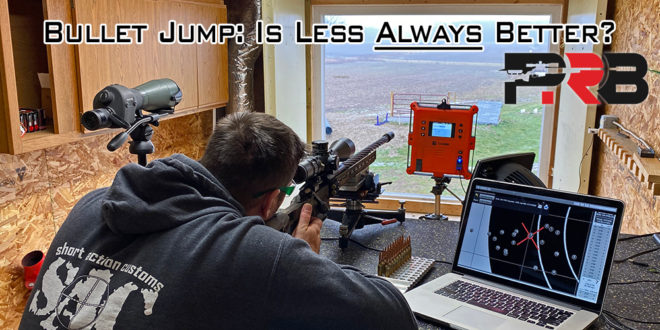
 precisionrifleblog.com
precisionrifleblog.com
The biggest reason I moved away from 6mmCM after two barrels.
My son and I shoot very mild 6mmBR’s now and I just switched them both over to 112 MatchBurners at just under 2700 FPS. They should last a good deal longer and be more stable than a Creedmoor at 3100 FPS.
The 1.775” CBTO length equates to 0.050” jump in my gun with a pretty fresh barrel.
And a related article on PRB with jump analysis...

Bullet Jump: Is Less Always Better?
About 2 years ago, Mark Gordon shared some preliminary research he’d conducted with the Applied Bal...
Last edited:
This is the person who has that data. Do you have comparable data or experience?I challenge anyone to post any long term, high confidence data that shows “nodes” act in the way this post describes.
And if you (anyone) can produce such data, I promise AB will be happy to have you out to shoot several days and several thousand rounds over their doppler to prove your method works long term.
Your powder would have to be extremely temp sensitive to require a re-zero in different weather conditions.
Here is one of many, many targets I have across different chamberings/rifles. This one happens to be across 2 full grains of varget. You can also ping @Ledzep for some pretty long term data which hasn’t uncovered anything that doesn’t fall in line with basic velocity math and such.
Lets hear more data about your targets across different chambering. i see a PO shift on that one. What chamber, and lets see some targets for other chambering perhaps with the chambering listed. Some chambering are very easy to load for some aren't. An ultrasiff MTU barrel and P shooter 6mm isn't exactly hard to load for. There is more to this than just 1+1=2. Skinnier barrels, and different chambering behave differently.
Power does not have to be extremely temp sensitive to have a POI shift as you run up in your OCW test. Set your powder charge on the edge of node, your POI will shift in different conditions. you will still be able to hit your 2 moa plate with your 27 pound 6mm Dasher though.
Last edited:
@ceekay1
The biggest reason I moved away from 6mmCM after two barrels.
My son and I shoot very mild 6mmBR’s now and I just switched them both over to 112 MatchBurners at just under 2700 FPS. They should last a good deal longer and be more stable than a Creedmoor at 3100 FPS.
The 1.775” CBTO length equates to 0.050” jump in my gun with a pretty fresh barrel.
And a related article on PRB with jump analysis...

Bullet Jump: Is Less Always Better?
About 2 years ago, Mark Gordon shared some preliminary research he’d conducted with the Applied Bal...precisionrifleblog.com
Ahh... 6BR/2700 .050" off, totally get it.
I'm doing similar, just instead of running the 6CM like a 6CM, I'm running it like a Dasher/6GT. Same deal: lasts longer, more stable.
Still on the fence about going to a smaller 6 though, since for me it might be more trouble than it's worth and might not be any different at all really from what I've already got.
...was looking up load info on 6GT today vs what I'm running currently, and based off what Hodgdon shows (and a little real world experience mixed in), I noticed something I hadn't really noticed before concerning the smaller 6's: if one just looks at charge weight, the load data can look deceiving if one forgets to take into account that most of the tried-and-true recipes involve/include Varget... In my experience 35gr of Varget (which is what it seems it takes most guys to get up to near 2900 with 6GT) is roughly equal to ~39gr of H4350, or... ~41gr of Sta-Ball, which is exactly what I'm using... so felt recoil is probably already about the same and I might not feel any improvement going to the smaller/newer/hipper cartridge.
Last edited:
Similar threads
- Replies
- 23
- Views
- 712
- Replies
- 19
- Views
- 996
